This post was originally published on Good Search
#cmsmasters_row_65046eb6763cd .cmsmasters_row_outer_parent {
padding-top: 20px;
}
#cmsmasters_row_65046eb6763cd .cmsmasters_row_outer_parent {
padding-bottom: 15px;
}
#cmsmasters_row_65046eb6764b4 .cmsmasters_row_outer_parent {
padding-top: 0px;
}
#cmsmasters_row_65046eb6764b4 .cmsmasters_row_outer_parent {
padding-bottom: 30px;
}
#cmsmasters_row_65046eb676546 .cmsmasters_row_outer_parent {
padding-top: 0px;
}
#cmsmasters_row_65046eb676546 .cmsmasters_row_outer_parent {
padding-bottom: 10px;
}
#cmsmasters_row_65046eb6765de .cmsmasters_row_outer_parent {
padding-top: 0px;
}
#cmsmasters_row_65046eb6765de .cmsmasters_row_outer_parent {
padding-bottom: 50px;
}
#cmsmasters_fb_65046eb676665 {
padding-top:20px;
padding-bottom:20px;
-webkit-border-radius:20;
border-radius:20;
}
#cmsmasters_fb_65046eb676665 .featured_block_inner {
width: 100%;
padding: ;
text-align: left;
float:left;
}
#cmsmasters_fb_65046eb676665 .featured_block_text {
text-align: left;
}
#cmsmasters_row_65046eb6766c0 .cmsmasters_row_outer_parent {
padding-top: 0px;
}
#cmsmasters_row_65046eb6766c0 .cmsmasters_row_outer_parent {
padding-bottom: 10px;
}
#cmsmasters_row_65046eb67676a .cmsmasters_row_outer_parent {
padding-top: 0px;
}
#cmsmasters_row_65046eb67676a .cmsmasters_row_outer_parent {
padding-bottom: 30px;
}
#cmsmasters_row_65046eb6768ca .cmsmasters_row_outer_parent {
padding-top: 0px;
}
#cmsmasters_row_65046eb6768ca .cmsmasters_row_outer_parent {
padding-bottom: 10px;
}
#cmsmasters_row_65046eb6769da .cmsmasters_row_outer_parent {
padding-top: 0px;
}
#cmsmasters_row_65046eb6769da .cmsmasters_row_outer_parent {
padding-bottom: 50px;
}
#cmsmasters_divider_65046eb676a38 {
border-bottom-width:0px;
border-bottom-style:solid;
padding-top:20px;
margin-bottom:0px;
}
#cmsmasters_row_65046eb676a59 .cmsmasters_row_outer_parent {
padding-top: 0px;
}
#cmsmasters_row_65046eb676a59 .cmsmasters_row_outer_parent {
padding-bottom: 10px;
}
#cmsmasters_row_65046eb676b2f .cmsmasters_row_outer_parent {
padding-top: 0px;
}
#cmsmasters_row_65046eb676b2f .cmsmasters_row_outer_parent {
padding-bottom: 50px;
}
#cmsmasters_divider_65046eb676b85 {
border-bottom-width:0px;
border-bottom-style:solid;
padding-top:20px;
margin-bottom:0px;
}
#cmsmasters_row_65046eb676ba5 .cmsmasters_row_outer_parent {
padding-top: 0px;
}
#cmsmasters_row_65046eb676ba5 .cmsmasters_row_outer_parent {
padding-bottom: 10px;
}
#cmsmasters_row_65046eb676c43 .cmsmasters_row_outer_parent {
padding-top: 0px;
}
#cmsmasters_row_65046eb676c43 .cmsmasters_row_outer_parent {
padding-bottom: 30px;
}
#cmsmasters_row_65046eb676db0 .cmsmasters_row_outer_parent {
padding-top: 0px;
}
#cmsmasters_row_65046eb676db0 .cmsmasters_row_outer_parent {
padding-bottom: 30px;
}
#cmsmasters_row_65046eb676ea5 .cmsmasters_row_outer_parent {
padding-top: 0px;
}
#cmsmasters_row_65046eb676ea5 .cmsmasters_row_outer_parent {
padding-bottom: 50px;
}
#cmsmasters_row_65046eb67724d .cmsmasters_row_outer_parent {
padding-top: 0px;
}
#cmsmasters_row_65046eb67724d .cmsmasters_row_outer_parent {
padding-bottom: 10px;
}
#cmsmasters_row_65046eb677360 .cmsmasters_row_outer_parent {
padding-top: 0px;
}
#cmsmasters_row_65046eb677360 .cmsmasters_row_outer_parent {
padding-bottom: 10px;
}
#cmsmasters_row_65046eb677477 .cmsmasters_row_outer_parent {
padding-top: 0px;
}
#cmsmasters_row_65046eb677477 .cmsmasters_row_outer_parent {
padding-bottom: 10px;
}
#cmsmasters_row_65046eb6774fd .cmsmasters_row_outer_parent {
padding-top: 0px;
}
#cmsmasters_row_65046eb6774fd .cmsmasters_row_outer_parent {
padding-bottom: 30px;
}
#cmsmasters_row_65046eb6775e5 .cmsmasters_row_outer_parent {
padding-top: 0px;
}
#cmsmasters_row_65046eb6775e5 .cmsmasters_row_outer_parent {
padding-bottom: 10px;
}
#cmsmasters_row_65046eb677676 .cmsmasters_row_outer_parent {
padding-top: 0px;
}
#cmsmasters_row_65046eb677676 .cmsmasters_row_outer_parent {
padding-bottom: 30px;
}
#cmsmasters_button_65046eb6777c1 {
float:left;
}
#cmsmasters_button_65046eb6777c1 .cmsmasters_button:before {
margin-right:.5em;
margin-left:0;
vertical-align:baseline;
}
#cmsmasters_button_65046eb6777c1 .cmsmasters_button {
font-weight:normal;
font-style:normal;
border-style:solid;
}
#cmsmasters_button_65046eb6777c1 .cmsmasters_button:hover {
}
#cmsmasters_row_65046eb6777f6 .cmsmasters_row_outer_parent {
padding-top: 0px;
}
#cmsmasters_row_65046eb6777f6 .cmsmasters_row_outer_parent {
padding-bottom: 50px;
}
#cmsmasters_divider_65046eb67784c {
border-bottom-width:1px;
border-bottom-style:solid;
padding-top:20px;
margin-bottom:0px;
}
#cmsmasters_row_65046eb677873 .cmsmasters_row_outer_parent {
padding-top: 0px;
}
#cmsmasters_row_65046eb677873 .cmsmasters_row_outer_parent {
padding-bottom: 10px;
}
Invasive species often harm the native flora and fauna. In the case of the beautiful water hyacinth, we are talking about a major catastrophe. Some initiatives are developing innovative ideas to contain its massive spread.
With globalisation, many animal and plant species are becoming permanently established in new habitats. Some of these alien, invasive species can cause massive ecological and economic damage. For example, they can greatly alter native flora and fauna and have negative impacts on the environment, the economy and human health. These newcomers often displace native species, disrupt ecosystems and cause ecological and high economic damage. The problem: once they have spread, it is usually too late to intervene. Only preventive or immediate action at a very early stage could help keep invasive species in check.
New additions to the ecosystem
They are usually introduced – intentionally or unintentionally – by human assistance into new areas where they do not occur naturally, e.g. through international trade, global travel or the introduction of crops for agricultural purposes. Some are also fleeing hostile environmental conditions, exacerbated by climate change, or, like microorganisms, can also spread naturally, e.g. through wind, water currents or animal transport. These include the online trade in exotic animals or plastic waste on which species can cross entire oceans. However, not all newly immigrated plants or animals are generally problematic. In fact, they could also become important substitute plants for native species that are increasingly disappearing from our ecosystems due to climate crisis, pests and plant diseases.
Water hyacinth – Innovative approaches to limit the damage of the fast-growing marsh plant
Tiger mosquito, zebra mussel, muskrat, red American swamp crayfish, the Asian carp, giant hogweed, perennial knotweed, the list is long – they all multiply rapidly because they lack natural predators in their new habitat. This also applies to the water hyacinth, native to the Amazon region, which is very popular as an ornamental plant worldwide. The problem: in the absence of natural enemies, it grows faster than bamboo and thus covers large areas in a short time. Its massive spread in East Africa had a major negative impact on fishing in Lake Victoria and the local water supply, and it now pollutes lakes, canals and riparian areas in all tropical regions.

We are supporting Char2Cool – Invasive weed as CO2 storage
Even experts could not imagine making charcoal from a plant that is 90 percent water. In 2019, the Char2Cool association successfully developed a process to produce biochar from the invasive water hyacinth. The name says it all: you produce charcoal (Char) to cool the climate (2 cool). With the business concept, local partners can set up their own production with little start-up capital. Charcoaling in the Char2Cool-designed stove is very easy to learn and access to the water hyacinth is open to all. so that one can create a stable source of income by selling charcoal. Farmers, in turn, benefit from fertile soils that produce larger yields. Sri Lanka also knows the problem. This is where Thomas Betzold founded his start-up Fuscum Soil Enhancer. In 2019, the Sri Lanka Water Authority invested over 50% of its annual budget in removing water hyacinths.
Harvest, dry and char water hyacinth: The idea is to convert a noxious plant into a soil improver that outperforms conventional fertilisers in efficiency. In addition to saving CO2, it binds methane, which is 86x more harmful than CO2 and is released in the annual cycle of each water hyacinth.
Char2Cool will be supported by GOOD in August 2023 – so with your searches, you can actively generate money for this project!
There are now a number of local initiatives that have taken up the idea of processing water hyacinth into biochar. The idea of Char2Cool is to have the process certified as CO2 compensation. Then the projects can partly finance themselves through the sale of CO2 certificates. Among the projects are:
Water Hyacinth Charcoal Project (Kenya) focuses on the recycling of water hyacinth through the production of biochar. Through production and sales, the project provides income opportunities for communities and helps address the environmental impacts of water hyacinths.
GreenHeat Energy Solutions (South Africa) uses water hyacinths as a renewable energy source. They collect the plants and use them to produce biochar as an environmentally friendly alternative to traditional charcoal and biogas used to generate electricity. This helps reduce water pollution from water hyacinths while creating jobs and sustainable energy sources.
Eco-Fuel Africa (Uganda) is a social enterprise in Uganda that collects water hyacinths and processes them into biochar. This biochar serves as a clean and environmentally friendly alternative to traditional charcoal and firewood sources. At the same time, the company creates jobs for local communities.
Water Hyacinth Biochar Initiative (Philippines) produces biochar from water hyacinth by pyrolysing the plants to produce a carbon-rich fuel. This biochar can be used as a soil conditioner, filter material or fuel and contributes to the sustainable use of water hyacinth.
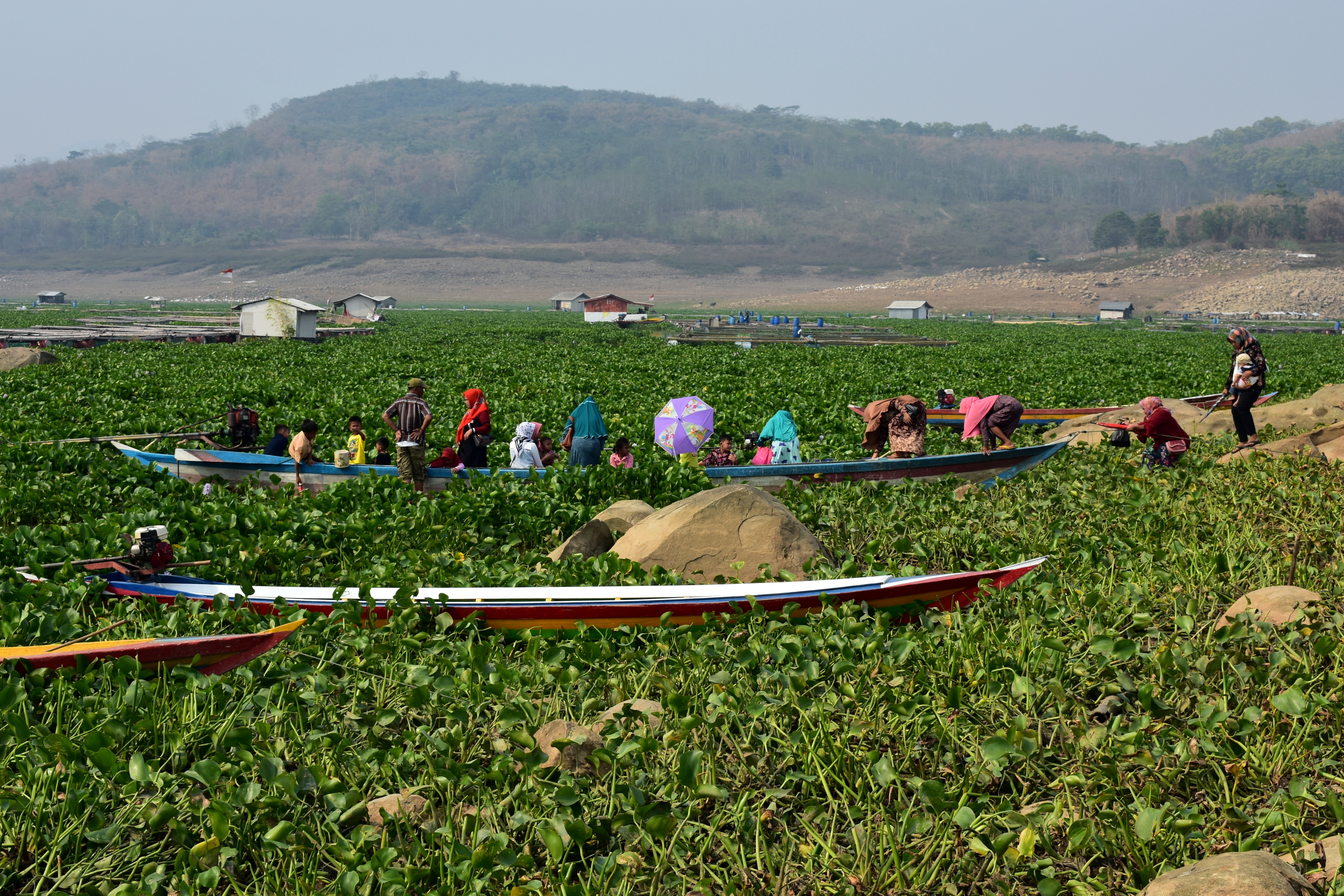
Water hyacinths as material for useful products
Other social enterprises are developing innovative approaches to the sustainable use of water hyacinths while creating social and economic benefits for local communities. A number of local initiatives use the cellulose of water hyacinth to make various products. The most far-reaching is the Cellurose Zero-Waste project of October 6 University from Egypt.

Cellurose (Egypt) The project, developed by students, aims to recycle as many parts of the water hyacinth – also known as the Nile rose in Egypt – as possible so that a self-sustaining business model can be developed from it. Cellurose has initiated various social start-ups that sell the following products:
- Protein-rich fish food made from the petals
- Medical gloves made from the cellulose extracted from the roots and stems, and
- the so-called “black liquor” fertiliser made from the waste of cellulose processing.Click here to see the students’ pitch at the Enactus Worldcup 2021, where Cellulose emerged as the winning project.

ECOWB – Ecologists without borders / The Water Hyacinth Project (TWH) (Kenya) is a social enterprise that focuses on processing water hyacinth. They work with local communities to collect the plants and transform them into useful products such as handbags, furniture and handicrafts. By selling these products, TWH creates jobs and income opportunities.
Further projects with a similar approach:
Water Hyacinth Handicraft Village (Sri Lanka) works with local communities to collect water hyacinths to make handmade products. This project provides income to community members while promoting environmentally friendly recycling of the plants.
Pearl Organic Products (Sri Lanka) is a company in Sri Lanka that makes products from natural and sustainable materials, including water hyacinths. They use the collected plants to make handmade bags, baskets and other products. The company creates jobs for local artisans and promotes environmental sustainability.
Water Hyacinth Craft (Philippines) is an organisation that works with women from rural communities to make handmade products from water hyacinths. Through training and the provision of employment, it supports income generation and sustainable livelihoods for women.
Invasive species as a valuable energy source
An economical and easily scalable option is to use water hyacinth to produce biogas. Here, the high moisture content is less of a problem than with biocharification. As far as households in the region have gas cookers, this is an attractive option to replace e.g. firewood with biogas.
Lagos Water Hyacinth Project (Nigeria): This project in Nigeria focuses on the environmentally friendly removal of water hyacinths from Lagos Lagoon. They use the harvested plants to produce biogas, which is used to generate energy. The project creates jobs while promoting sustainable development.
Biogas International (Lake Victoria, Kenya): There is a scientifically accompanied pilot project at Lake Victoria that produces biogas from water hyacinth to supply the neighbouring villages.
Perhaps the most unusual approach is Ecofiltro from Guatemala. The social enterprise focuses on providing clean drinking water. They have developed a water filtration system that uses water hyacinths as a filter medium. The use of these filters both removes water hyacinths and provides clean drinking water.
Water hyacinths for clean drinking water

The perhaps most unusual approach is Ecofiltro from Guatemala. The social enterprise focuses on providing clean drinking water. They have developed a water filtration system that uses water hyacinths as a filter medium. The use of these filters both removes water hyacinths and provides clean drinking water.
MEHR ZUM PROJEKT
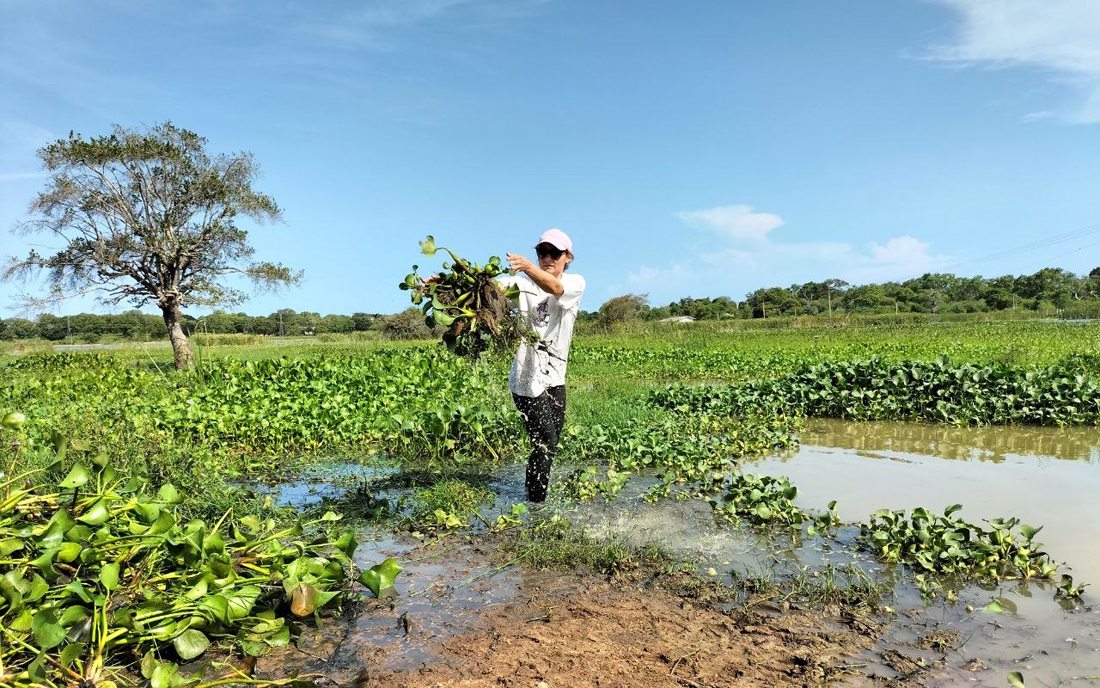
Char2Cool
We are supporting Char2Cool in August 2023 with the proceeds from GOOD. Find out more on our project page:
Questions, Critique, Ideas? Message us!
Andreas Renner, Co-Founder GOOD: andreas@good-search.org
The post On the mission against invasive species appeared first on GOOD – The search engine for a better world.


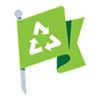
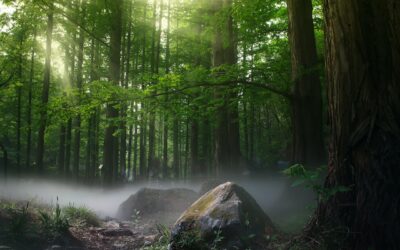
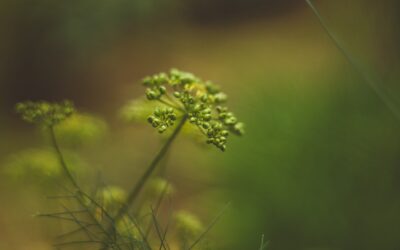
0 Comments